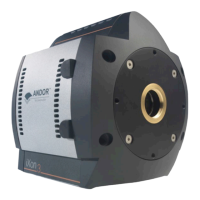Page 57
Features & Functionality
3.9 - PUSHING FRAME RATES WITH CROPPED SENSOR MODE
The iXon3 offers Cropped Sensor Mode, which carries the following advantages:
• Specializedreadoutmodeforachievingveryfastframerates(sub-millisecondexposures)from‘standard’
cameras.
• Continuousrapidspoolingofimages/spectratoharddisk.
• Userselectablecroppedsensorsize–highlyintuitivesoftwaredenition.
• TheiXon3isnowavailablewiththecomplementaryOptoMaskaccessory,whichcanbeusedtoshieldthe
region of the sensor outside of the cropped area.
If an experiment demands fast temporal resolution, but cannot be constrained by the maximum storage size of the
sensor (as is the case for ‘Fast Kinetics Mode’ of readout), then it is possible to readout the iXon3 in ‘Cropped Sensor
Mode’. In this mode, the user denes a ‘sub-array’ size from within the full image sensor area, such that it encompasses
the region of the image where change is rapidly occurring (e.g. a ‘calcium spark’ within a cell). The sensor subsequently
“imagines”thatitisofthissmallerdenedarraysize,achievedthroughsoftwareexecutingspecialreadoutpatterns,and
reads out at a proportionally faster frame rate. The smaller the dened array size, the faster the frame rate achievable.
In order to use Cropped Sensor mode, one has to ensure that no light is falling on the light sensitive area outside of the
dened region. Any light collected outside the cropped area could corrupt the images which were acquired in this mode.
Formicroscopyset-ups,thisisnowaidedwithanaccessorycalledOptoMask,availablefromAndor.
Cropped Sensor Mode has the end result of achieving a much faster frame rate than that obtainable in a conventional
‘sub-array’/ROIreadout(duringwhichwewouldstillhavetoverticallyshifttheunwantedrows).Theframerateincrease
is achieved by not reading out (i.e. discarding) the unwanted pixels.
Figure 41: Cropped Sensor Mode. The active imaging area of the sensor is dened in a way that only a small section of the entire chip is used for
imaging. The remaining area has to be optically masked to prevent light leakage and charge spill-over that would compromise the signal from the
imaging area. By cropping the sensor one achieves faster frame rates because the temporal resolution will be dictated by the time it requires to
read out small section of the sensor.

